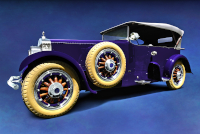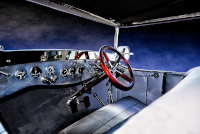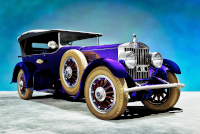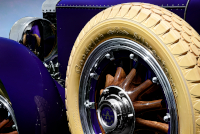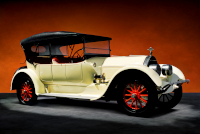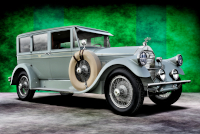Location:
Elegance at Hershey, 2016
Owner: Mr. & Mrs. Robert S. Jepson, Jr. | Savannah, Georgia
Prologue:
Review contemporary photos of the Roscoe Arbuckle Model 66-A and you will see a clear separation between those that depict a deep blue-tint as opposed to the car's ridiculous (in a nice way) heliotrope paint. The brighter the sun, the more the mirror-reflective finish changes the color with blue sky dissolution. In studio surrounds, the pure heliotrope hue comes through without disruption from the mirror effect. Of course I photograph outside, on-location. So finding the correct hue and carrying that value through each image proved tricky during the illustration process. So too, the size and complexity of the wheels and wheel rims creates a lot of work to achieve a decent glow-reflect ratio. Add a set of tyres cast in white rubber, (no hiding them in shadow), and we've got ourselves an intimidating project. Still, I had been eager to dive in and finish the set, despite my wariness over the effort involved. In the end, I've only half convinced myself. The foreshortened perspectives work, particularly the main image (1) and tail portrait (4), but I know that better circumstances and a longer lens would do wonders for the shape as Harley J. Earl envisioned. Otherwise, the car proved too big to capture with decent fidelity in this particular live setting.
- - - - - - - - - -
► Image Source 1, 3-7: Nikon D750 (24.3 MP) | Image Source 2 by E, illustrated by the author: Nikon D200 (10.2 MP)
References:
- Ralston, Marc. "Pierce-Arrow" A.S. Barnes & Co., Inc., San Diego, CA. 1980, page 88, 110, 231
- Automobile Quarterly, Volume 28, Number 4, Fourth Quarter 1990, "The Big Pierces" by Bernie Weis, The Kutztown Publishing Company, Inc., Kutztown, PA, page 51
- Coachbuilt: A very nice piece on Don Lee Coach & Body Works, with notes on Pierce-Arrow chassis #A4562.
- Jay Leno's Garage: Jay provides a very nice description of his late-production 1918 Pierce-Arrow Model 66-A, and of cours a requisite ride-along.
- Smithsonian Magazine: "The Skinny on the Fatty Arbuckle Trial," by Gilbert King, November 8, 2011.
Don Lee Coach & Body Works is the nexus of two California car culture families, the Earls and the Lees. J.W. Earl established Earl Automobile Works (né Carriage Works) in Los Angeles in 1889. His son, Harley, is that same Harley J. Earl of General Motors Art and Colour Department fame. Meanwhile, to call Don Lee a prominent car dealer sells short his influence on the birth of television. Lee acquired radio stations to promote his dealer network and in the process created the Don Lee Network, which later merged with CBS to become the Don Lee-Columbia Network, CBS' west coast affiliate. That group experimented with some of the first television broadcasts in the country. His son, Tommy, is the Tommy Lee who collected and raced exotics at a time when few shared the same appreciation. (His name will emerge frequently in front of anyone researching classic Alfa Romeo cars in America.) The two families combined when Lee purchased Earl Automobile Works in 1919, retaining Harley as chief designer. That timeline makes this Pierce-Arrow, chassis #A4652, a bellwether design exercise—an early Harley Earl design under new Don Lee ownership.
Chassis A4652 is best known as the favorite ride of Roscoe "Fatty" Arbuckle—silent film star, the highest paid man in Hollywood. The car is significant for its design, developed under Harley J. Earl in the early stages of his career just after his family firm's acquisition by Don Lee. A rarity at the time, hardly anyone used a Pierce-Arrow chassis for custom coachwork because, in the first place, the factory provided obsessive quality control that an independent firm would struggle to match, and in the second place, Pierce-Arrow built cast-aluminum bodies of exceptional durability through a process no other factory or custom coachbuilder could replicate. Pierce-Arrow were also among the most expensive automobiles in the world. Only a Hollywood giant like Arbuckle would be of the mind or means to customize a Pierce-Arrow. All in, the total bill for the chassis and the coachwork cost a reported $34,000, which translates to nearly $600,000 in our contemporary currency.
But this Pierce-Arrow also represents a tumult in Hollywood history, with implications stretching across the country, and perhaps even so far as today's reignited cancel culture debate.
The Cancel Culture Curse: Roscoe "Fatty" Arbuckle and the St. Francis Hotel
Arbuckle, who has commissioned Earl for two previous custom coachwork automobiles, turns to the family once more under the Don Lee brand. His Pierce-Arrow Model 66 is to be bombastic, a car equal to his own stature. As the chassis is powered by the largest internal combustion motor ever put into production, (and as it is a Pierce-Arrow besides), the project seems to include the correct mix people and machinery to create what could be the most incredible custom automobile to date.
Now in January of 1919, the Congress ratifies the 18th Amendment, criminalizing alcohol sales. (Of course, Arbuckle's Pierce-Arrow includes a bootleg chest under the rear floor, like many Prohibition-era customs of the day.) Enter two years of prosperity for the actor, culminating in a $3-million contract with Paramount Pictures in 1921 for a battery of 18 silent films. One can find many photographs of Arbuckle and A4562 taken during this period. Then in September of 1921, 25-year-old actress Virginia Rappe dies during a gin party at San Francisco's St. Francis Hotel. An uninvited guest, her story becomes the fodder of a rape and murder case against Arbuckle that will subject him to three trials, force the liquidation of his estate, and end his career. In truth, Rappe died of natural causes accelerated by her own behavior, and the brou-ha-ha had been conjured up by another uninvited guest, one Maude Delmont, who conspired with the prosecution to tap Arbuckle for all he was worth.
Cancel culture is no new phenomenon, and no case is perhaps as egregious as the destruction of Fatty Arbuckle. At the close of his third and final trial, the jury deliberates for five minutes only to write an apology and appeal to the public to consider Arbuckle's good nature. The delay in his acquittal has much to do with Arbuckle's own reluctance to call witnesses who spoke against the character of the deceased, unraveling the motives of his accusers, which by the end of the ordeal only makes his plight more sympathetic. No such luck, however, as years of flogging in the media permanently tarnish Arbuckle's reputation. He would not use his name again professionally, and worked only behind the scenes in a modest capacity.
Back to the matter of automobiles, this Pierce-Arrow is the crowned artefact that best represents Arbuckle's great success, and his great loss. Arbuckle had in fact taken his Pierce-Arrow for service immediately before the party, and while at the garage, suffered second-degree burns after sitting on an acid-soaked rag. He had been tempted to cancel his trip to San Francisco, but his friend and fellow actor-director Fred Fischbach convinced him otherwise, even furnishing a rubber ring so that Arbuckle could make the drive. So this car is not only representative of the ordeal, but a witness to the ignition point. That the Pierce-Arrow is a Harley J. Earl design and one of the most extraordinary cars of the day is all the more impressive.
Motor: 13,519.3 cc (825 cubic inch) inline 6-cylinder | 127 mm x 177.8 mm (5" x 7")
The motor is cast iron, cast in pairs of three cylinders, and is the largest motor ever fitted to a production vehicle. The 13.5 litre motor is an upgrade from the original 11,700 cc unit. The advance occurred around 1913, enlarging the bore and stroke from 5¼ x 5½ inches to a round 5 x 7 inches.
While the Model 66 officially ended production in 1918, Pierce-Arrow did produce a limited fifth series from 1918 to 1919. Marc Ralston notes: "The only engine that was standard in the Series 5 cars was the 48-horsepower dual-valve engine. Yet this factory drawing shows a 66-A-5 dual-valve engine. It apparently was never made in any quantity, yet a few were actually sold in cars." Specifications for the uncatalogued Model 66-A-5 would follow updates for the latest dual-valve layout (actually a 4-valve-per-cylinder head), which Pierce-Arrow will develop into the Model 51 in lieu of further developing the Model 66. We can only assume that #A4562 runs a Series 4 motor with two valves per cylinder and not one of the experimental Series 5 motors, despite its 1919 sales date.
Valvetrain: T-head, dual-valve, dual ignition
Aspiration: single updraft carburetor
Power: 66 rated horsepower @ 1,600 rpm
Actual power output for the motor is 143 hp as tested by the factory on a dynamometer.
Drivetrain: 4-speed manual transmission, rear-wheel drive
Architecture: steel frame
Kerb Weight: 2,494.7 kg (5,500 lbs)
Wheelbase: 3,746.5 mm (147.5 inches)
Etymology:
'66' denotes rated horsepower, though well below the actual output. The Model 66 enjoyed surprising longevity for a car powered by the largest motor ever fitted to a production vehicle, beginning in 1910 as successor to the Model 60QQ, (and to some extent, the little-known 65Q of 1908). Henceforth, the 66 settled at the top of Pierce-Arrow's 36UU, 48SS, and 66QQ triumvirate. In 1913, these models adopted the new (and somewhat redundant) C, B, and A nomenclature, respectively, with series numerals tacked on the end in successive years. (The Model 36UU advanced to the Model 38-C, the 48SS became the 48-B, and the Model 66QQ became the 66-A.) In any case, the Model 66 lived from 1910 to 1918 through two separate alphanumeric systems. The nomenclature '66-A-4' indicates the fourth production run of the Model 66 since the nomenclature change-over in 1913, even though the Model 66QQ had been produced for a few years prior.
Strictly speaking, Model 66 production ended in 1918 with the arrival of the superior Model 31 and Model 51 cars. Pierce-Arrow did produce a Series 5 from 1918 to 1919, but only officially catalogued the Model 48-B-5 in that production run. That said, historian Marc Ralston notes that Pierce fitted and sold a few 66-A-5 dual-valve motors in that period, (Pierce's term for a four-valve-per-cylinder head), and his history includes images of the fifth series Model 66 motor. However, it is unlikely chassis #A4562 runs the experimental four-valve motor, despite its sales date, and is instead a very late Series 4 as every other reference indicates.
Figures:
Pierce-Arrow produced 505 A-type Series 4 cars from 1916 to 1918. This particular chassis must have emerged toward the end of production, and may have required time enough for custom coachwork logistics to postpone sale until 1919.
Value:
The chassis cost $6,000 originally, nevermind its lack of Pierce-Arrow aluminum coachwork. The spare-no-expense cost of customization cost a further $25,000, though Coachbuild cites a figure of $28,000 as recollected by Harley J. Earl himself.
Another interesting anecdote, Arbuckle's insurance agency used him and his car to advertise their services, drafting a postcard with his coverage limits printed across a photograph of him at the wheel of A4562. The message seems to be, if we can insure the richest man in Hollywood, we can insure you. The insured loss value the Behrendt-Levy Co. offered on the car was $20,000, which is less than two-thirds the original cost, but still a monumental sum for a single automobile.
Early Earl: A Predictive Styling Exercise Years before GM
Before Harley J. Earl led the General Motors Art and Colour Department, he was chief designer at Earl Automobile Works under his father, J.W. Earl. 1919 is a year of conjunction in which Don Lee purchases the Earl family coachworks and Roscoe "Fatty" Arbuckle gives his third commission to the Earls. Harley then creates a car that will convey Arbuckle to the peak of his career, right up to the cataclysmic end—and not just by way of metaphor, but physically taking him to the point where all hell breaks loose in San Francisco, September, 1921. (Period photos also depict Arbuckle arriving at court in this Pierce-Arrow.) As for the design, Earl leveled the bonnet and the cowl, creating a slab-side with firm shoulders and a low curve over the bonnet. This approach is unlike most production vehicles, as typically the bulkhead joined two distinctly different components, a bulbous cowl and a rounded bonnet. But A4265 uses neither.
13 Years Ahead: Design Precedent in Harley Earl's Pierce-Arrow Custom
The bonnet shape is similar to a Daimler of the same period, though the scale is much greater. While contemporary Daimlers use a nose of similar shape, the nose is set very low against the cowl, nothing so fluid as this Pierce-Arrow. That said, if we extrapolate the similarity between the Pierce-Arrow and Daimler over the decades, Earl's 1919 custom Pierce-Arrow is shockingly similar to the Daimler Double-Six of the early 1930s. By that time, coachwork exercises on Bentley and Delage chassis will also use a similarly smooth approach. Of course Cadillac will also adopt these lines by the late 1920s, a result of Earl's direct influence on General Motors. But no exercise is quite so similar as the Daimler Double-Six. In particular, compare this 1919 Pierce-Arrow with the 1932 Daimler Double-Six 40/50 Sport Saloon by Martin Walter Ltd. Both use a nearly identical cowl and bonnet treatment, slab sides free of running gear, cycle fenders, and separate front and rear steps. Ahead by 13 years, Harley demonstrates that the trends he created are more than next-season alterations made at the behest of corporate influence, but deep-seeded inclinations toward the optimal automotive shape.
Built for Arbuckle, the car leads with the 'RCA' personalization on the radiator cowl, indicating his full name, Roscoe Conkling Arbuckle. There are six barrel lamps total—two up front, two on the cowl, and two on the flanks between the doors—but no traditional marker lights. The front steps float, fixed to the chassis, while the rear steps are integrated within the curiously curved rear fenders. The U-shaped design creates a sort of upside-down vestibule, a deep footwell. Small round lights illuminate both the front and rear steps. The car is all flank and no flutter, free of ornament in deference to its orca-smooth contours and strong shoulders. Door seams melt into the body, and louvres on the bonnet sides and chassis rails are narrow, unobtrusive slits that hide within the reflective finish.
Heliotrope Bouquet: Comments on Color
The finish on this Pierce-Arrow is amazing, almost as if there is a liquid glass layer on top of the paint. Paint depth, in this case, is a trick of the eye and difficult to describe. The effect seems as if the paint lies at the back of a mirror such that light and color are thrown up and out through the glass surface. I have seen similar effects on custom automobiles, particularly under airbrushed art work in the style of Southern California low riders, but nothing of this sort on a concours show field. The inner rim that clamps on the artillery wheel uses the same paint, with matching Arrow 'A' insignia in the hubs. A trunk rack and polished steel skids finish the tail. White rubber tyres offset the paint, though I also like the stance of the car in black rubber with the hood down, as shown in some period photographs.
Last Updated: Mar 26, 2025

